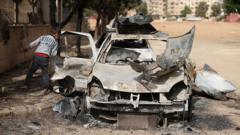The newly established Syrian government, striving for unity post-Assad, grapples with persistent sectarian violence, raising fears among minority populations amidst continued attacks and the complexities of armed groups in different regions.
Syria's New Era: Challenges of Sectarian Violence in the Wake of Civil War

Syria's New Era: Challenges of Sectarian Violence in the Wake of Civil War
As a new government emerges in Syria after the fall of the Assad regime, minority groups face ongoing threats from extremist factions.
In the aftermath of the civil war that toppled Syrian dictator Bashar al-Assad in December, the nascent government is facing daunting challenges in its mission to unify a fractured nation. While ambitious plans are underway, persistent sectarian violence threatens to destabilize efforts, creating deep-seated fears among the country’s diverse minority communities.
In recent violence, attacks by Islamist militants in April led to numerous fatalities in neighborhoods around the capital, Damascus, primarily affecting the Druse minority population. The situation escalated further when Israel intervened with airstrikes, asserting its intent to protect these vulnerable groups. This flurry of violence follows a tragic event earlier in the year, where approximately 1,600 individuals from the predominantly Alawite coastal region lost their lives due to extremist incursions, as documented by the Syrian Observatory for Human Rights.
Observers highlight that many of those responsible for these heinous acts are believed to be affiliated with the more radical elements of the rebel coalition that dismantled the Assad regime. Despite assurances from the new government to integrate all factions into a consolidated national military, a significant number of extremist groups have remained outside governmental oversight, complicating the security landscape.
Syria’s rich tapestry of minority communities, including the Druse, Alawites, and Kurds, has given rise to a myriad of armed groups. Throughout the nearly 14 years of the civil war, both the Druse and Kurdish populations formed their own militia forces, and these entities have yet to disband despite the formal end of hostilities. Moreover, former members of the Alawite sect, now at odds with the new regime, have also taken up arms against it, exacerbating the complexity of the situation.
In this critical period of national rebuilding, the plight of Syria’s minorities hangs in the balance, raising pressing questions about the government’s capacity to provide security and foster a real sense of unity among its citizens.




















